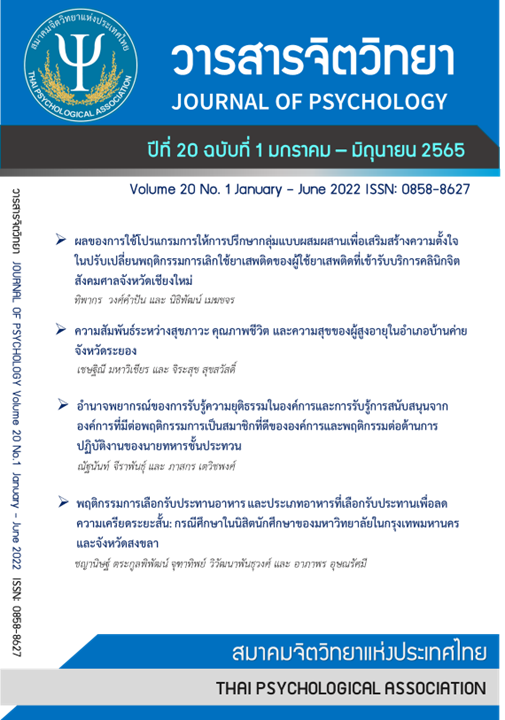Craving on food and comfort food choice for short-term stress relief: The case study of university students in Bangkok and Songkhla
Main Article Content
Abstract
Food consumption are found to be popular choices to relieve stressful and anxious mind. This research aims to study food choice, craving on foods, and eating effect of foods among undergraduate students in Thailand. Participants were 347 undergraduate students (66% female) from 2 universities in Bangkok and one university in Songkhla. The questionnaire asked participants to rate their frequency, level of craving, and mood improving effect among 40 food choices (e.g., Western, Asian, and Thai foods). As a result of Mixed-design ANOVA analysis, we found interaction of gender and food types (F (3, 976) = 4.33, p < .05), the study site and food types (F (6, 1009) = 10.01, p < .001) on frequency of eating and level of craving on food, but neither effect of gender, nor study site are found on mood improving effect of food. We found no effect of BMI on any food rating.
Article Details

This work is licensed under a Creative Commons Attribution-NonCommercial-NoDerivatives 4.0 International License.
บทความที่ได้รับการตีพิมพ์เป็นลิขสิทธิ์ของสมาคมจิตวิทยาแห่งประเทศไทย
ข้อความที่ปรากฎในบทความแต่ละเรื่องในวารสารวิชาการเล่มนี้เป็นความคิดเห็นส่วนตัวของผู้เขียนแต่ละท่านไม่เกี่ยวข้องกับสมาคมจิตวิทยาแห่งประเทศไทย แต่อย่างใด ความรับผิดชอบองค์ประกอบทั้งหมดของบทความแต่ละเรื่องเป็นของผู้เขียนแต่ละท่าน หากมีความผิดพลาดใด ๆ ผู้เขียนแต่ละท่านจะรับผิดชอบบทความของตนเองแต่ผู้เดียว
References
รัตนา พรหมพิชัย. (2542). วัฒนธรรมการรับประทานอาหารของชาวล้านนา. ใน สารานุกรมวัฒนธรรมไทย ภาคเหนือ . กรุงเทพฯ: มูลนิธิสารานุกรมวัฒนธรรมไทย ธนาคารไทยพาณิชย์.
สุนีย์ วัฑฒนายน. (2014). 6 อาหาร ท้องถิ่น วัฒนธรรมการกินแบบพื้นบ้านสืบสานสู่อาเซียน. วารสารมหาวิทยาลัยนราธิวาสราชนครินทร์ สาขา มนุษยศาสตร์ และ สังคมศาสตร์, 1(1).
Adam, T. C., & Epel, E. S. (2007). Stress, eating and the reward system. Physiology & behavior, 91(4), 449-458. doi.org/10.1016/j.physbeh.2007.04.011
Cervellon, M. C., & Dubé, L. (2005). Cultural influences in the origins of food likings and dislikes. Food quality and preference, 16(5), 455-460. doi.org/10.1016/j.foodqual.2004.09.002
Finch, L. E., Cummings, J. R., & Tomiyama, A. J. (2019). Cookie or clementine? Psychophysiological stress reactivity and recovery after eating healthy and unhealthy comfort foods. Psychoneuroendocrinology, 107, 26-36. doi.org/10.1016/j.psyneuen.2019.04.022
Han, W., Tellez, L. A., Niu, J., Medina, S., Ferreira, T. L., Zhang, X., ... & De Araujo, I. E. (2016). Striatal dopamine links gastrointestinal rerouting to altered sweet appetite. Cell metabolism, 23(1), 103-112. doi.org/10.1016/j.cmet.2015.10.009
Komatsu, S. (2008). Rice and sushi cravings: a preliminary study of food craving among Japanese females. Appetite, 50(2-3), 353-358. doi.org/10.1016/j.appet.2007.08.012
Locher, J. L., Yoels, W. C., Maurer, D., & Van Ells, J. (2005). Comfort foods: an exploratory journey into the social and emotional significance of food. Food & Foodways, 13(4), 273-297. doi.org/10.1080/07409710500334509
Mansour, A. T., Hamed, H. S., El-Beltagi, H. S., & Mohamed, W. F. (2022). modulatory effect of papaya extract against chlorpyrifos-induced oxidative stress, immune suppression, endocrine disruption, and dna damage in female Clarias gariepinus. International Journal of Environmental Research and Public Health, 19(8), 4640. doi.org/10.3390/ijerph19084640
Moritz, B., Schmitz, A. E., Rodrigues, A. L. S., Dafre, A. L., & Cunha, M. P. (2020). The role of vitamin C in stress-related disorders. The Journal of Nutritional Biochemistry, 85, 108459. doi.org/10.1016/j.jnutbio.2020.108459
Oba, K., Noriuchi, M., Atomi, T., Moriguchi, Y., & Kikuchi, Y. (2016). Memory and reward systems coproduce ‘nostalgic’experiences in the brain. Social cognitive and affective neuroscience, 11(7), 1069-1077. doi.org/10.1093/scan/nsv073
Rozin, P., Fischler, C., Imada, S., Sarubin, A., & Wrzesniewski, A. (1999). Attitudes to food and the role of food in life in the USA, Japan, Flemish Belgium and France: Possible implications for the diet–health debate. Appetite, 33(2), 163-180. doi.org/10.1006/appe.1999.0244
Spence, C. (2017). Comfort food: A review. International journal of gastronomy and food science, 9, 105-109. doi.org/10.1016/j.ijgfs.2017.07.001
Tryon, M. S., Stanhope, K. L., Epel, E. S., Mason, A. E., Brown, R., Medici, V., ... & Laugero, K. D. (2015). Excessive sugar consumption may be a difficult habit to break: a view from the brain and body. The Journal of Clinical Endocrinology & Metabolism, 100(6), 2239-2247. doi.org/10.1210/jc.2014-4353
Wagner, H. S., Ahlstrom, B., Redden, J. P., Vickers, Z., & Mann, T. (2014). The myth of comfort food. Health Psychology, 33(12), 1552. doi.org/10.1037/hea0000068
Wahlqvist, M. L. (2007). Regional food culture and development. Asia Pacific journal of clinical nutrition, 16, 2.
Wang, O., De Steur, H., Gellynck, X., & Verbeke, W. (2015). Motives for consumer choice of traditional food and European food in mainland China. Appetite, 87, 143-151. doi.org/10.1016/j.appet.2014.12.211
Wansink, B., Cheney, M. M., & Chan, N. (2003). Exploring comfort food preferences across age and gender. Physiology & behavior, 79(4-5), 739-747. doi.org/10.1016/S0031-9384(03)00203-8
Wansink, B., Sonka, S. T., & Cheney, M. M. (2002). A cultural hedonic framework for increasing the consumption of unfamiliar foods: soy acceptance in Russia and Colombia. Applied Economic Perspectives and Policy, 24(2), 353-365. doi.org/10.1111/1467-9353.00102
Wright, L. T., Nancarrow, C., & Kwok, P. M. (2001). Food taste preferences and cultural influences on consumption. British Food Journal. doi.org/10.1108/00070700110396321
Zellner, D. A., Garriga-Trillo, A., Rohm, E., Centeno, S., & Parker, S. (1999). Food liking and craving: A cross-cultural approach. Appetite, 33(1), 61-70. doi.org/10.1006/appe.1999.0234

